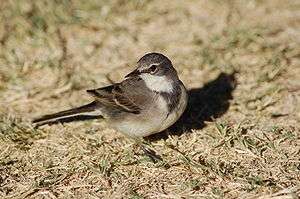Cape wagtail
| Cape wagtail | |
|---|---|
 | |
| At Fish River Canyon, Namibia | |
| Scientific classification | |
| Kingdom: | Animalia |
| Phylum: | Chordata |
| Class: | Aves |
| Order: | Passeriformes |
| Family: | Motacillidae |
| Genus: | Motacilla |
| Species: | M. capensis |
| Binomial name | |
| Motacilla capensis Linnaeus, 1766.[2] | |
The Cape wagtail, also known as Wells's wagtail, (Motacilla capensis) is a small African passerine bird in the family Motacillidae, which includes the wagtails, pipits and longclaws.
Description
The cape wagtail is a rather dull plumaged and relatively short tailed wagtail with olive grey upperparts and face with a buff supercilium and dark lores. The underparts are creamy white and may show a faint pinkish wash on the lower breast and belly. The breast band is dusky and the sides of the breast and the flanks are olive-grey. The brownish black wings have pale edges to the feathers and the tail is blackish with the two outer tail feathers being white. The juveniles are similar to the adults but browner above and yellower below.[3]
Distribution
Cape wagtails are found in eastern and southern Africa from Uganda, the eastern Democratic Republic of the Congo and Kenya, through Zambia and Angola to southern Africa, south to the Western Cape and the Cape of Good Hope.[4]
Habitat
Cape wagtails can be found in almost any habitat that has open ground adjacent to water, and also along the rocky coastline, in farms, villages, cultivated land, parks, gardens and urban centres.[4] In east Africa it is generally found above 2,000 m (6,600 ft) in altitude.[3]
Biology
The Cape wagtail's main food is invertrebrates foraging is mainly on the ground or in shallow water, often feeding on animals that are already dead. It has been recorded taking insects attracted to lights in the early morning or caught in car radiators. Other than insects it has been recorded as eating fiddler crabs, sandhoppers, snails, ticks, tadpoles, small fish, small chameleons and human food.[4]
The Cape wagtail is a monogamous, territorial solitary nester and breeding pairs stay together over a number of breeding seasons. Like many territorial birds the males often fiercely attack their own reflection in mirrors or windows. The nest is built by both sexes and consists of a cup made of a wide range of materials, both natural and artificial, which is lined with hair, rootlets, wool and feathers. The nest is situated in a recess within a steep bank, tree, bush or frequently sited in a man-made site, such as a hole in a wall, pot plant or bridge. It breeds all year round but, egg-laying peaks from July until December. One to five eggs are laid, which both sexes incubate for 13–15 days. Once hatched the chicks are fed by both parents, until they leave the nest after 14–18 days. Once fledged they adults continue to feed them for another 20–25 days, and the young become fully independent after 44 days from fledging, occasionally up to 60 days.[4]
It has been recorded as host of the following brood parasites diderick cuckoo Chrysococcyx caprius, Jacobin cuckoo Clamator jacobinus and Levaillant's cuckoo Clamator levaillantii. Predators include the rufous-breasted sparrowhawk Accipter rufiventris, as well as cats and rats Rattus spp.[4]
Subspecies
Three subspecies are currently recognised:[2]
- Motacilla capensis capensis: Namibia to Zimbabwe and Mozambique
- Motacilla capensis wellsi: Highlands of the eastern Democratic Republic of the Congo to Uganda and Kenya
- Motacilla capensis simplicissima: Angola to south eastern Democratic Republic of the Congo, Zambia, the Caprivi Strip, Botswana and Zimbabwe
References
- ↑ "Motacilla capensis (Cape Wagtail)". The IUCN Red List of Threatened Species. International Union for Conservation of Nature and Natural Resources. Retrieved 22 October 2016.
- 1 2 "Cape Wagtail Motacilla capensis Linnaeus, 1766". Avibase. Denis Lepage. Retrieved 22 October 2016.
- 1 2 Zimmerman, Dale A.; Turner, Donald A.; Pearson, David J. (1996). Birds of Kenya and Northern Tanzania. Helm. pp. 505–506. ISBN 0-7136-3968-7.
- 1 2 3 4 5 "Motacilla capensis (Cape wagtail)". Biodiversity Explorer. Iziko Museums of South Africa. Retrieved 22 October 2016.
- Sinclair, Hockey and Tarboton, SASOL Birds of Southern Africa, ISBN 1-86872-721-1
External links
- Cape wagtail - Species text in The Atlas of Southern African Birds.
